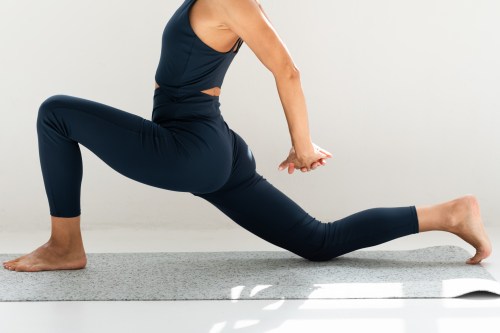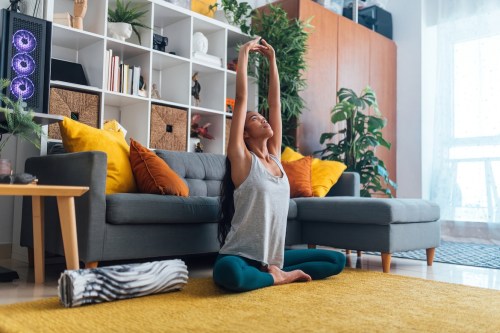I’ve practiced and studied yoga for many years now, but I can still remember my early days, when I would itch to get off my mat during Savasana. The stillness felt like torture—I would rather have done 40 more chaturangas than lie there motionless. There were even mornings where I’d scope out a spot next to the door so I could be the first to sneak out of the room as soon as class was over.
Years of practice and hundreds of hours of teacher training later, I’ll admit that at times stillness can still be very difficult for me. Not just within the four corners of my mat, but within the overall framework of my life.
Often when we think of yoga, we think of going to a studio, rolling out a mat, and moving to the guidance offered by an instructor. But the physical poses that we take during class, known as asana, are actually just a small part of yoga.
In yoga, Svadhyaya is the practice of studying oneself. It is the fourth of the Niyamas, or rules, of conduct applied on an individual level. The Niyamas are one of the eight limbs of yoga laid out in the Yoga Sutra. (Asana, or pose, is just one of the limbs.)
I cannot pinpoint when things started to change for me in Savasana. But overtime, the stillness became more tolerable, and then it even became… inviting.
When I look back now, I can clearly see that the physical practice was transforming the way I faced difficulty, both on and off my mat.
In stillness, I am forced to look at everything I constantly moved away from. When things get quiet and there is space to look at what is really there (or what is not), it can be difficult to sit with oneself. Going through the motions of my life at a steady pace meant less room for unpredictable events. Less room to lose control and more space to feel comfortable.
In the early years of my practice, I was most comfortable moving through a class at a one-breath, one-movement pace. I told myself that this was the style of yoga I liked and felt most connected to. In class, when a guide would ask us to remain in a pose for several breaths, I’d have to refrain my urges to keep moving at a familiar cadence. At times, I’d feel myself staring daggers at the guide in extended side angle as they adjusted a student or gave another verbal cue that kept us all in the pose for an extra cycle of breath.
I started to question why the stillness and pause were difficult for me. This questioning itself can be seen as part of self-study, a fruitful part of practice. I wanted my practice to grow into more of an inward exploration. I wondered: what made me want to keep moving from shape to shape without pause? Where else does this show up? Is there a pattern in the way I practice, in the way I face challenges?
I was escaping difficulty on my mat the way I escaped difficulty in my life—by quickly moving on from one thing to the next. I didn’t want to hold the challenge of a shape, I wanted to get in, get out, and move onto the next. Where was I doing that in my life off the mat?
Bit by bit, I changed my approach. In the pauses, I took time to notice the physical details of the postures. I brought my attention to what my hands and my feet were doing. And then, what my fingers and my toes were doing. And then, what my breath and my gaze were doing. With time, I noticed how amazing each of these details can be once I started to study them. And bit by bit, stillness became a more intriguing study of myself.
This tool of simple observation began to transfer from my mat to various aspects of my life. I noticed I used to fill my weekends with social commitments, hopping from one place and friend to the next, with little down time or stillness in between. I saw I felt much more fulfilled when I focused on the quality of my interactions rather than quantity. By committing to less, I began to feel more present. It was similar to the feeling I have on my mat – so alive in each moment of simply breathing.
Each detail of the practice—the way you gaze in a pose (drishti), the way you transition from one shape to the next, the reactions you have to challenging moments, the way you leave your mat—are all sources of information to understand more about the person you are. Further, these are opportunities to shape the person you want to be…on and off your mat.
When an asana class ends, it may be the closure of that hour of physical practice, but it is really the beginning of how you take your practice with you into your world. The patterns you observe about yourself as you physically move from pose to pose, are a study of the way you move from moment to moment in your life.
How to apply Svadhyaya to your asana practice and your life
To illustrate how to apply the concept of Svadhyaya to the physical practice of yoga, we’ll walk through a few yoga poses that are frequently taught in public classes with a self-study lens.
These poses are not necessarily meant to be done in a sequential order, rather you can use these examples next time you’re in a public class or practicing at home to study yourself.
1. Utthita Trikonasana (Extended Triangle Pose)
Stand on your mat and step your feet 3 to 4 feet apart. If you have a block, place it on the outside of the right foot on the highest height to begin. Raise your arms out to the side so that they are parallel with the floor. Turn your left foot 15 degrees in and turn your right foot out to 90 degrees. Line up your right heel with your left heel. Press your feet into the ground, stand up tall as you inhale, exhale and take your right hand down to the block. Adjust the block so that it lines up right underneath your shoulder. Stack to top hand over the shoulders, open your torso towards the left and keep both sides of the torso even. Breathe here for 5 to 10 cycles.
As you breathe in the pose, notice the details of your hands and feet. Do your feet feel securely pressed to the ground? If you feel like your feet could easily move, spread your toes out wide and pull the inner arches of your feet upwards. Does this change the way the pose feels for you? Are you standing in the pose with a sense of greater purpose?
As you gaze up at your top hand, look at the finger tips. If the finger tips are folding complacently, sharpen the fingers and observe what it feels like to reach with a sense of intention. The way you reach in a pose can change the way your energy level and commitment feel in a moment.
As you study these small shifts of attention to detail in asana, you might notice this kind of attention to detail off your mat. For instance, in a moment of your day when you feel anxious or frustrated, bring your attention to your hands. Notice what taking the fingers from clenched to relaxed can on an emotional level.
2. Vriksasana (Tree Pose)
Stand with both feet on the ground and your hands on your hips. Shift your weight to your left foot and turn your right knee out and place the sole of your foot on your left calf or inner thigh. Bring your hands together at your heart. Breathe here for 5 to 10 cycles.
As you remain in the pose, draw your attention down to the roots of the tree. Notice if the toes are spread out wide. The surface area you take up, your points of contact with the ground give you stability.
Are your hands pressed together with a sense of action? What does the palm to palm, skin to skin connection feel like?
Where is your gaze focused? Find something steady in front of you to gaze at. Once you do, soften the inner and outer corners of your eyes. Notice how keeping your vision soft and steady can change the way the moment feels.
The way you gaze directly impacts your nervous system response. You can take this aspect of self-study off your mat too. In a moment where you feel distracted or frazzled off your mat, notice what your eyes are doing. Most of the time when we are anxious, our eyes move quickly and even bulge out. If you steady your focus and soften the way you look outwards, your body and mind will respond accordingly.
3. Utthita Parsvakonasana (Extended Side Angle)
Stand on your mat and step your feet 4 feet apart. Raise your arms out to the side, face your palms downwards. Take a breath in to stand tall, breathe out and turn your right toes out to 90 degrees and bend your right knee until your thigh is parallel with the ground. Angle the left toes in at 15 degrees. Place your right hand on your mat outside of your right foot, or on a block outside of your foot, or take your forearm to your thigh and rest it lightly. Stretch your left arm over your left ear, turn your palm to face down. Breathe in this shape for 5 to 10 breath cycles.
Move through the details of the hands and feet as we have in the poses above. Notice if your feet are secured to the ground. Bring your attention to the flesh of each toe and press it downwards as you pull the arches of your feet upwards. Notice the effort of the fingertips, especially the top hand.
Next, bring your attention to your torso, specifically your side body. Is one side feeling much more of the effort than the other? Is the torso dumping downwards so that you can reach the ground? See if you can adjust the pose so that both sides of the body feel light and long. This may mean adding a block or taking it to a higher height sutra.
What does it feel like to bring a sense of equanimity to the pose by evening out the efforts of the sides? Can you also do the same to the upper vs. lower body effort? How does this change the way the shape feels for you? How does this naturally change the way you breathe and gaze in the posture?
Often, we think of yoga poses as targeted towards one part of the body. When we do this, we lose touch with the whole-body effort request to bring a sense of calm to each posture.
You might notice this on your mat and (surprise!) see if reflect in your life. When we overwork one part of our body in a physical practice, we might end up leaving our mats feeling over worked in that area or worse, injured. When we tax one part of our lives we find ourselves burnt out. Learning to balance out the effort on your mat can help you think about how to bring equanimity to the parameters of your life.
4. Savasana (Corpse Pose)
Here is where the study of stillness gets very real. It can feel jarring to be asked to become still. Whenever I come into my own savasana or guide it in class, I encourage one to first get out any fidgets, itches, or whatever small movements need to happen out of the way. After this, lay on your back and widen your feet, let your toes angle outwards. Before coming into stillness, I like to Rest your arms alongside your body with your palms face up. Take a moment to settle into this shape – get any fidgets out, scratch an itch if you need, but move with the intention of truly coming into stillness. Once set up, let the fingers and toes completely unfurl any tension. Imagine your bones are heavying and that the ground underneath you has a quality of give to it, like putty or sand. Let your body fully receive this give.
Finding stillness in yoga and your life
Once you are settled into stillness, notice where your mind goes. Are the thoughts racing in and taking over? Are you feeling an urge to move forward with your day? This is your chance to examine why.
See if you can let yourself watch your thoughts. See them come in and without clinging or judging them, let them pass by. Keep practicing this pattern, again and again.
When you do move off your mat from savasana, move slowly. And take note of one observation you made about yourself in stillness. Imprint it in your mind so that you can connect the dots when it shows up in your life off your mat. Remember, the way you breathe and move on your mat has the power to shape the way you breathe and move in your life.
Oh hi! You look like someone who loves free workouts, discounts for cutting-edge wellness brands, and exclusive Well+Good content. Sign up for Well+, our online community of wellness insiders, and unlock your rewards instantly.
Sign Up for Our Daily Newsletter
Get all the latest in wellness, trends, food, fitness, beauty, and more delivered right to your inbox.
Got it, you've been added to our email list.











